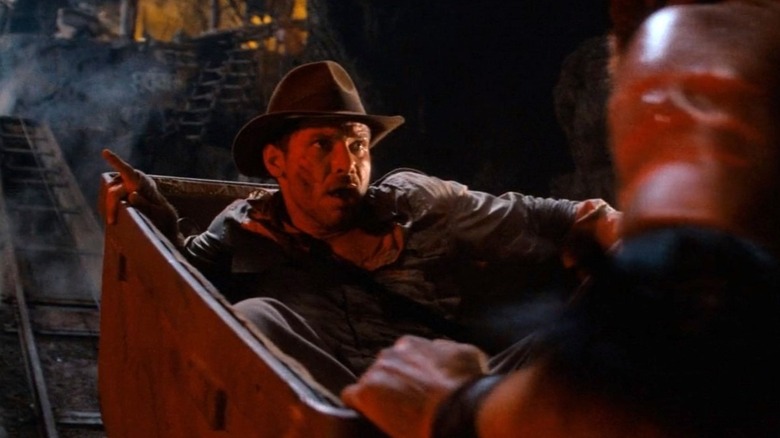Indiana Jones And The Temple Of Doom: How They Shot That Bonkers Mine Cart Scene
While director James Mangold had all sorts of digital effects wizards at his disposal to make "Indiana Jones and the Dial of Destiny," Steven Spielberg resorted to some old-school visual techniques nearly 40 years ago when crafting "Indiana Jones and the Temple of Doom."
"The Temple of Doom" has several dazzling action scenes, and perhaps the most intense sequence comes when Indy (Harrison Ford), his young assistant Short Round (Ke Huy Quan), and showgirl Willie Scott (Kate Capshaw) attempt to escape Thuggee high priest Mola Ram's (Amrish Puri) underground mining lair. As such, the trio ends up in a mine cart that wildly cascades along the rails of a mine shaft as Mola Ram's temple guards attempt to capture them.
In a 2022 episode of the web series "VFX Artists React" on The Corridor Crew, a trio of visual effects artists — Wren Weichman, Sam Gorski, and Niko Pueringer — break down key moments in the mine cart chase. Upon closer inspection, the trio reveals how the live-action execution of the scene was produced in tandem with some tried-and-true visual effects techniques. "I wanted to point out this one because every wide shot of an environment is a miniature," Gorski said, while Pueringer added, "How they got some of these shots, I don't know because it looks so good. [It's like] they must have built tracks and carts and had [the actors use them]."
At least portions of the mine cart scene were practical, Gorski said, noting there was no compositing — the combination of different visual elements to give the illusion of one image — with the closeup scenes.
Some mine cart shots were done the same way as scenes in The Empire Strikes Back
Released in 1984, "The Temple of Doom" is technically the first film in the "Indiana Jones" timeline, although the second installment to be released after the 1981 action-adventure classic, "Raiders of the Lost Ark." Directed by Steven Spielberg and co-written and produced by George Lucas, the filmmaking team relied on some similar effects Lucas used in "Star Wars: Episode V — The Empire Strikes Back."
Among the elements was the use of miniature mine cars and dolls of Indiana Jones, Short Round, and Willie Scott — something The Corridor Crew didn't realize until they started pausing footage to get a closer look at some frames. They concluded that the set piece was accomplished through the use of blue screen for the stars to act in front of, as well as a camera technique known as "go-motion."
Gaining an understanding of how go-motion was utilized, Sam Gorski asked, "Just so we're on the same page, is go-motion where you have everything move while you take your exposure?" Wren Weichman answered, "Yeah, you set up everything, and then you have the camera and whatever you are going to [move] when you hit the shutter."
As an example of go-motion, The Corridor Crew showed footage of an All-Terrain Armored Transport (AT-AT) vehicle and a tauntaun beast moving in a pair of different scenes in "The Empire Strikes Back."
Some scenes in The Temple of Doom were filmed via stop-motion animation
Making the mine cart sequence in "Indiana Jones and the Temple of Doom" even more amazing was that the go-motion of the shots was enhanced by stop-motion animation. "So, this is go-motion, but now, you're having dolls animated in stop-motion at the same time the go-motion's happening," Sam Gorski observed. "Every technique under the sun is used in this scene, so they do a really good job blending these different techniques together."
The visual effects shots in the mine cart scene were blended in such an expert manner that Niko Pueringer remarked, "It looks so real." Wren Weichman was equally impressed, noting, "They actually managed to replicate this sort of realistic camera motion — this camera shake — on top of everything being stop-motion."
Chief among the techniques used in the mine cart scene, naturally, was the live-action shots, and as part of the core cast of "Indiana Jones and the Temple of Doom," Kate Capshaw confirmed the enormity of the set she, Harrison Ford, and Ke Huy Quan were filming on.
Capshaw told the eponymous host of NBC's "Late Night with David Letterman" in 1984 that the cars and rails were built to scale. "They literally made a roller coaster inside this very large set," Capshaw told Letterman. "It moved like a rollercoaster, but it moved slower."


